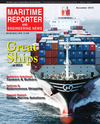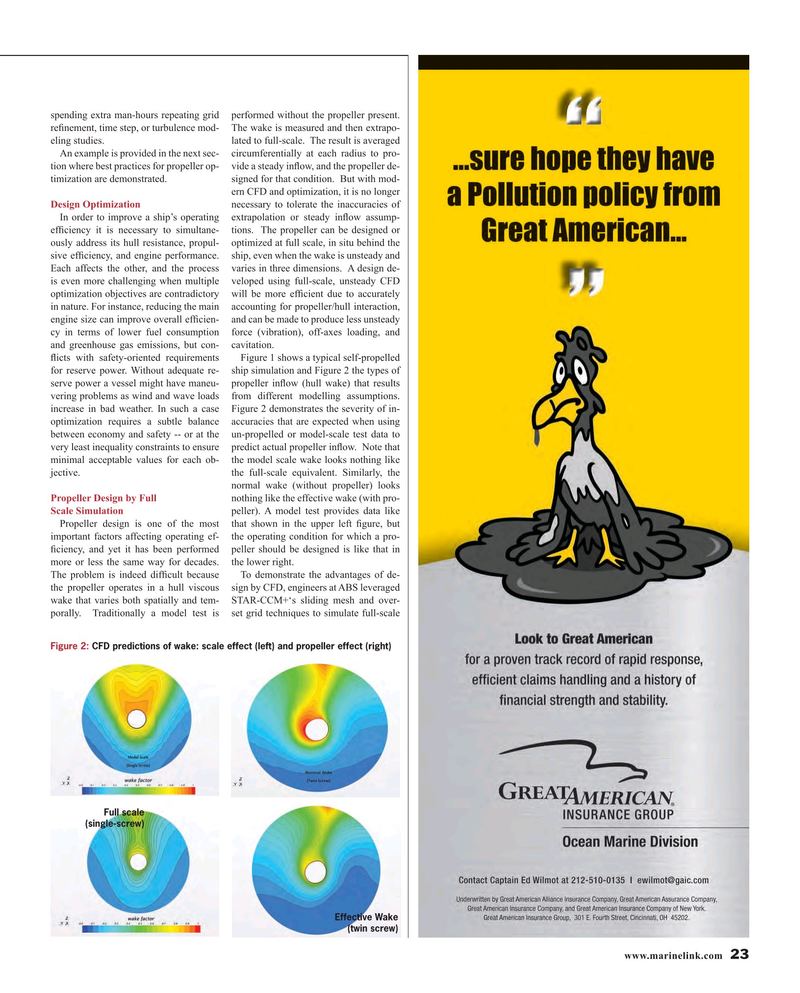
Page 23: of Maritime Reporter Magazine (December 2015)
Great Ships of 2015
Read this page in Pdf, Flash or Html5 edition of December 2015 Maritime Reporter Magazine
spending extra man-hours repeating grid performed without the propeller present. re? nement, time step, or turbulence mod- The wake is measured and then extrapo- eling studies. lated to full-scale. The result is averaged
An example is provided in the next sec- circumferentially at each radius to pro- tion where best practices for propeller op- vide a steady in? ow, and the propeller de- timization are demonstrated. signed for that condition. But with mod- ern CFD and optimization, it is no longer
Design Optimization necessary to tolerate the inaccuracies of
In order to improve a ship’s operating extrapolation or steady in? ow assump- ef? ciency it is necessary to simultane- tions. The propeller can be designed or ously address its hull resistance, propul- optimized at full scale, in situ behind the sive ef? ciency, and engine performance. ship, even when the wake is unsteady and
Each affects the other, and the process varies in three dimensions. A design de- is even more challenging when multiple veloped using full-scale, unsteady CFD optimization objectives are contradictory will be more ef? cient due to accurately in nature. For instance, reducing the main accounting for propeller/hull interaction, engine size can improve overall ef? cien- and can be made to produce less unsteady cy in terms of lower fuel consumption force (vibration), off-axes loading, and and greenhouse gas emissions, but con- cavitation. ? icts with safety-oriented requirements Figure 1 shows a typical self-propelled for reserve power. Without adequate re- ship simulation and Figure 2 the types of serve power a vessel might have maneu- propeller in? ow (hull wake) that results vering problems as wind and wave loads from different modelling assumptions. increase in bad weather. In such a case Figure 2 demonstrates the severity of in- optimization requires a subtle balance accuracies that are expected when using between economy and safety -- or at the un-propelled or model-scale test data to very least inequality constraints to ensure predict actual propeller in? ow. Note that minimal acceptable values for each ob- the model scale wake looks nothing like jective. the full-scale equivalent. Similarly, the normal wake (without propeller) looks
Propeller Design by Full nothing like the effective wake (with pro-
Scale Simulation peller). A model test provides data like
Propeller design is one of the most that shown in the upper left ? gure, but important factors affecting operating ef- the operating condition for which a pro- ? ciency, and yet it has been performed peller should be designed is like that in more or less the same way for decades. the lower right.
The problem is indeed dif? cult because To demonstrate the advantages of de- the propeller operates in a hull viscous sign by CFD, engineers at ABS leveraged wake that varies both spatially and tem- STAR-CCM+‘s sliding mesh and over- porally. Traditionally a model test is set grid techniques to simulate full-scale
Figure 2: CFD predictions of wake: scale effect (left) and propeller effect (right)
Full scale (single-screw)
Effective Wake (twin screw) www.marinelink.com 23
MR #12 (18-25).indd 23 12/4/2015 11:33:09 AM

 22
22

 24
24
